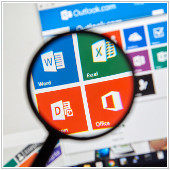If the name wasn’t clear enough, ‘bloatware’ is unnecessary manufacturer software that comes preloaded on new hardware. Just about no one likes it, and now Microsoft is giving us a tool to trim the fat. It may seem like small potatoes to anyone who hasn’t spent an afternoon removing apps one by one, but for […]
 If the name wasn’t clear enough, ‘bloatware’ is unnecessary manufacturer software that comes preloaded on new hardware. Just about no one likes it, and now Microsoft is giving us a tool to trim the fat. It may seem like small potatoes to anyone who hasn’t spent an afternoon removing apps one by one, but for the rest of us it’s a welcome blessing. Let’s take a minute to examine Windows’ new tool a little more closely.
If the name wasn’t clear enough, ‘bloatware’ is unnecessary manufacturer software that comes preloaded on new hardware. Just about no one likes it, and now Microsoft is giving us a tool to trim the fat. It may seem like small potatoes to anyone who hasn’t spent an afternoon removing apps one by one, but for the rest of us it’s a welcome blessing. Let’s take a minute to examine Windows’ new tool a little more closely.
If this software isn’t trying to drive you back to the manufacturer's sales stream, it’s paid a hefty chunk of change to be included on off-the-shelf hardware. Regardless of which it is, it’s not there to help you -- it’s there solely to increase the manufacturer’s bottom line. So if you think bloatware just isn’t enough of a concern to waste time refreshing your Windows install, consider that PCs without it start up 104% faster, shutdown 35% faster and have approximately 30 more minutes of battery life.
Because this isn’t a new problem, we’ve seen similar removal tools in the past, but they didn’t offer the same level of usability. When using Windows 8’s ‘Refresh and Rest’ the bloatware either wasn’t removed, or if it was, Windows required the reentry of a license key and a lengthy install completely from scratch. ‘Refresh’ Windows swiftly replaces everything on your hard drive with a fresh version of the OS as if it came straight from Microsoft.
Although this tool is best suited for clearing unwanted programs off of your machine right after you’ve purchased it, there’s no reason that you can’t use it further down the road. You might be thinking, “No way, I’ve got way too much important information to sacrifice it all just for a clean install.” Well depending on the extent of your data, that isn’t a problem.
When you open the ‘Refresh Windows’ client there’s only one option you need to select before moving forward, ‘Keep personal files only’ or ‘(Keep) Nothing’. Selecting the former will keep everything stored in your ‘Music’, ‘Pictures’, ‘Videos’ and ‘Documents’ folders. Remember that documents (in these folders) created or edited using Microsoft Office will be kept but the Office suite itself will be removed. Make sure you still have the licenses and installation disks for every piece of software you plan to use after the refresh.
This new feature will accompany next month’s Windows update, but users who just can’t wait to squash annoying ‘crapware’ can find the tool here. Simply download, open, and choose if you want to keep any personal files -- one, two, done.
You may be able to adequately navigate your way around a Windows machine, but there are often shortcuts that insiders use to speed up otherwise mundane management tasks. For any Windows projects or problems you have, drop us a line, we’ll have them fixed faster than you can uninstall that CD-burner utility that you never asked for.

 For the past couple of years, Microsoft’s smartphones have been struggling to keep up with Android and Apple devices. Although Microsoft sells their handsets at lower price points and are constantly trying to improve user experience, the Windows Phone just isn’t cutting it in the consumer market. So what’s happening to Microsoft’s smartphone business? Let’s find out.
For the past couple of years, Microsoft’s smartphones have been struggling to keep up with Android and Apple devices. Although Microsoft sells their handsets at lower price points and are constantly trying to improve user experience, the Windows Phone just isn’t cutting it in the consumer market. So what’s happening to Microsoft’s smartphone business? Let’s find out.
 SMBs see a lot of benefits to utilizing browser-based software, but generally avoid implementation for privacy and security concerns. Microsoft has finally addressed these issues by allowing businesses to host Microsoft Office locally. Popular pieces of software that usually take up a lot of space can now be securely accessed through a private cloud. Read on to learn more about this service and its viability in your office.
SMBs see a lot of benefits to utilizing browser-based software, but generally avoid implementation for privacy and security concerns. Microsoft has finally addressed these issues by allowing businesses to host Microsoft Office locally. Popular pieces of software that usually take up a lot of space can now be securely accessed through a private cloud. Read on to learn more about this service and its viability in your office.